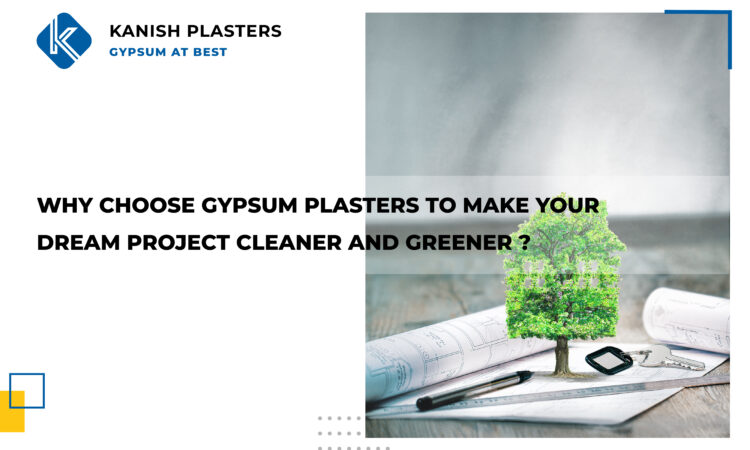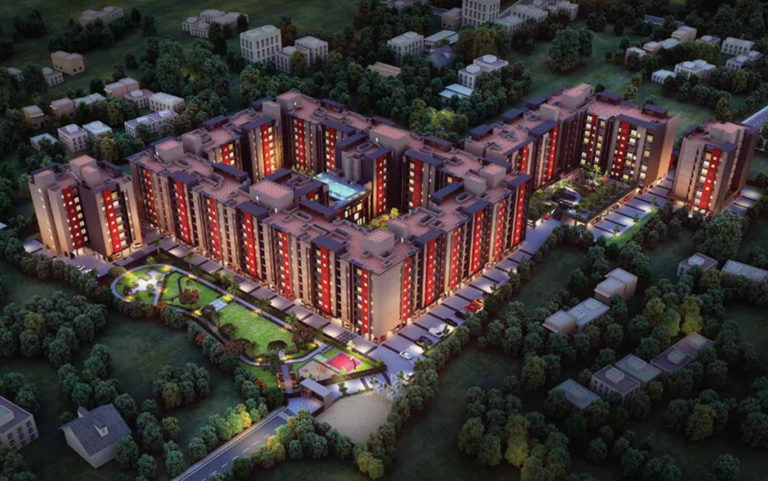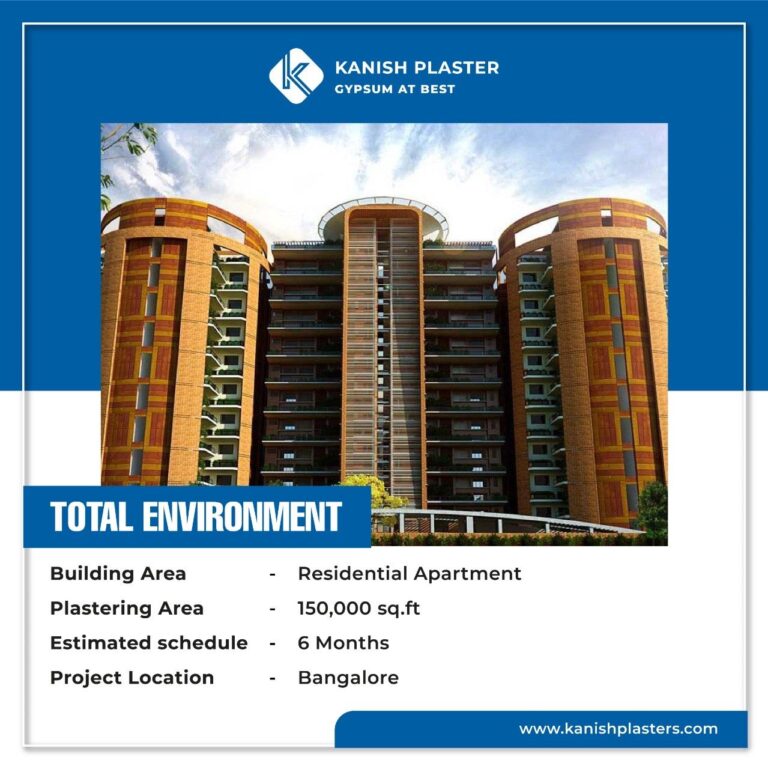The construction sector has witnessed several new trends in recent years. Technological advancements and innovations across applications are all aimed at making construction faster and delivering higher performance. Gypsum plaster has been in use since centuries in the construction field due to its excellent properties.
Gypsum Plaster was used by ancient Egyptians, because of its durability. It was used for plastering the pyramid at Cheops and as an internal plaster in the pyramid of Giza. Still, it has rarely been used extensively in the construction industry. However, over the past few decades, gypsum plaster has gained popularity over lime and cement plasters for both undercoat and finish plaster. Gypsum plastering has been in usage across Europe, south-east Asia since the 1960s and almost all major builders in Indian metro are now using this plaster for more than a decade. (Construction Dimensions, March 1985, p:27-29)
What is Gypsum plaster?
Gypsum is a soft sulphate mineral containing Calcium Sulphate Dihydrate (CaSO4:2H20), found in natural white rock form and widely used in fertilizers, moulds, sculptures and as gypsum plaster. Dry gypsum powder is mixed with water to get a hardened, white cementing material made by partial or complete dehydration of the gypsum.
This material is applied over block, brick or concrete surface to form a smooth surface and to prevent cracks and peel offs. It is ready to use and only requires adding water. It does not need sand and offers excellent acoustic and thermal properties while giving levelled walls a smooth interior finish and is an ideal base for good quality paints and wallpaper finishes. Gypsum plaster is easy to apply unlike the traditional cement mortar and so it requires less skilled manpower.
Properties of Gypsum Plaster:
- Thickness
It should be applied in the thickness of 6 -20mm to avoid cracks. The thickness of the undercoat of gypsum plaster is normally 11mm for walls and 8mm for the ceiling while that of finish coat plaster is 2mm.
- Colour of Finished Surface – White
- Setting Time – 25-30 Minutes
- Coverage Area (12mm thickness) – 21ft2/ bag
- Package Size – Bag of 25 kg
Types of Gypsum Plasters for construction
Types of gypsum plasters available in the market based on the amount of heat applied during the production:
- Anhydrite gypsum plaster is produced by heating gypsum to 1700C
- Hemihydrate gypsum plaster is produced by heating gypsum to more than 1700C.
Types of gypsum plasters based on the type of application:
- Casting Gypsum Plaster
- Undercoat Gypsum Plaster
- Finish Gypsum Plaster
- One Coat Gypsum Plaster
- Machine applied Gypsum Plaster
Advantages of using Gypsum plasters
- Gypsum plastering is time-saving, it is ready for the next process in 72 hours. Hence the cost of the project is reduced.
- Construction wastage during application is negligible.
- It is easily workable for an excellent finish so putty application is not required.
- It is a chalk-like material and is so light-weight that it does not increase the structural load on the building. It is 40% lighter than cement/Lime plaster, which adds up significantly to the dead weight of the building.
- Gypsum exhibits bonding properties so it can be applied to most kinds of surfaces.
- As the gypsum plastering is pure white, the space looks large and beautiful.
- Gypsum plaster is a pre-mix and available in easy-to-handle packs.
- It can be easily applied and mould into different shapes for decorative purposes, setting time of gypsum plaster can be controlled and also the time gap required between two successive coats are less.
- It gives a smooth finish to the surface and is compatible with all types of paints and primers.
- It does not shrink during drying and hardening processes.
- It is less prone to cracks.
- Gypsum has natural sound absorbent properties that make it suitable for schools, thin-wall apartments and multiplexes.
- Gypsum is non-combustible as it contains a high content of crystal water. In case of fire, it acts as a barrier and protects the blockwork, concrete and steel.
- It prevents rusting of metal fittings.
- Gypsum plastering has low thermal conductivity and saves on air conditioning bills. It is an ideal choice for green buildings.
- It ensures energy/ power saving and reduces long term electricity bills.
- Gypsum plastering gives high tensile and flexural strength.
- Gypsum plaster is unaffected by insects/ roaches and does not favour the growth of fungus.
Gypsum Plaster vs popular construction plasters
River/Sand Plasters
Illegal sand mining in rivers has led to the depletion of sand in the streambed and along the coastal areas resulting in deepening of rivers and estuaries, and the enlargement of river mouths and coastal inlet. To protect the river waters across the nation, the ‘National Green Tribunal’ (NGT) has taken action against illegal sand mining. Non-availability of river sand has significantly increased the construction prices while also slowing down the construction speed. Sand screening is also a major challenge in itself at a construction site. Sand plaster requires 7 days of water curing to set and attain full strength. Water is an expensive resource in many construction sites and also the labour cost involved in applying for 7 days adds up to the final cost of construction.
Cement – M Sand Plaster
M sand is not produced with consistent quality to meet the market demand. The strength and effects of M sand plaster are also not known to the market as it has not been tested over time. Applying putty is mandatory on top of M sand because the final finish of sand cement plaster is rough, adding more to the final cost. Sand screening is also a major challenge at the construction site. Cement plaster develops shrinkage cracks as it has the property of heat hydration.
Plaster mix needs to be mixed in a specific ratio. It is a big challenge and needs proper monitoring when managed by contractors. There are many possibilities of the mix changing, contamination, loss of cement paste, and incorrect water-cement ratio.
Gypsum Plaster
Gypsum plaster is completely recyclable and environment friendly. Gypsum plaster’s main constituent is stucco, obtained from mines after heating the gypsum rock that goes back to its original form providing required strength after adding water to it. The best quality gypsum is mined in Iran and Dubai.
Gypsum plastering is one of the ancient architectural finishing techniques, applied to give a visually pleasing smooth surface to a wall that acts as a protective cover for bricks and other building material from rain and wind. Different types of gypsum plasters are available in the market, depending on the different requirements. You must contact Kanish Plasters, for deals in construction products in the market like Gyproc, JK Gypsumaxx, Imported Gypsum, etc. They import only the best quality gypsum for your dream project, anywhere in India.



